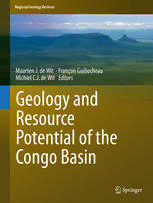
Geology and Resource Potential of the Congo Basin PDF
Preview Geology and Resource Potential of the Congo Basin
Regional Geology Reviews Maarten J. de Wit · François Guillocheau Michiel C.J. de Wit Editors Geology and Resource Potential of the Congo Basin Regional Geology Reviews SeriesEditors RolandOberha¨nsli MaartenJ.deWit Franc¸oisM.Roure More information about this series at http://www.springer.com/series/8643 . Maarten J. de Wit (cid:129) Franc¸ois Guillocheau (cid:129) Michiel C.J. de Wit Editors Geology and Resource Potential of the Congo Basin Editors MaartenJ.deWit Franc¸oisGuillocheau AEON-AfricaEarthObservatory Geosciences Network,andESSRI-Earth UniversityofRennes StewardshipScienceResearchInstitute RennesCedex NelsonMandelaMetropolitanUniversity France PortElizabeth SouthAfrica MichielC.J.deWit Geology UniversityofPretoria Pretoria SouthAfrica ISBN978-3-642-29481-5 ISBN978-3-642-29482-2(eBook) DOI10.1007/978-3-642-29482-2 SpringerHeidelbergNewYorkDordrechtLondon LibraryofCongressControlNumber:2014959861 #Springer-VerlagBerlinHeidelberg2015 Thisworkissubjecttocopyright.AllrightsarereservedbythePublisher,whetherthewholeorpartofthematerialis concerned,specificallytherightsoftranslation,reprinting,reuseofillustrations,recitation,broadcasting,reproduction on microfilms or in any other physical way, and transmission or information storage and retrieval, electronic adaptation, computer software, or by similar or dissimilar methodology now known or hereafter developed. Exemptedfromthislegalreservationarebriefexcerptsinconnectionwithreviewsorscholarlyanalysisormaterial suppliedspecificallyforthepurposeofbeingenteredandexecutedonacomputersystem,forexclusiveusebythe purchaserofthework.Duplicationofthispublicationorpartsthereofispermittedonlyundertheprovisionsofthe CopyrightLawofthePublisher’slocation,initscurrentversion,andpermissionforusemustalwaysbeobtainedfrom Springer.PermissionsforusemaybeobtainedthroughRightsLinkattheCopyrightClearanceCenter.Violationsare liabletoprosecutionundertherespectiveCopyrightLaw. Theuseofgeneraldescriptivenames,registerednames,trademarks,servicemarks,etc.inthispublicationdoesnot imply,evenintheabsenceofaspecificstatement,thatsuchnamesareexemptfromtherelevantprotectivelawsand regulationsandthereforefreeforgeneraluse. Whiletheadviceandinformationinthisbookarebelievedtobetrueandaccurateatthedateofpublication,neitherthe authorsnortheeditorsnorthepublishercanacceptanylegalresponsibilityforanyerrorsoromissionsthatmaybe made.Thepublishermakesnowarranty,expressorimplied,withrespecttothematerialcontainedherein. Coverillustration:PhotobyEdmondThorose Aerialview(helicopterflyingatca.150maboveground)lookingnortheastacrossthesouthwesternCongoBasin,215km southwestofKinshasa,withoutliersofpoorlyconsolidatedredsandstonesoftheKwangoGroup(Jurassic-Cretaceous) capped by a subhorizontal hardpan of Cenozoic silcrete. These outliers represent the nothernmost remnants of the KalahariPlateau,regionalpeneplanationsurface(“theAfricanSurface”)thatiswellpreservedatca.1000macross southernAfrica. Printedonacid-freepaper SpringerispartofSpringerScience+BusinessMedia(www.springer.com) ThiSisaFMBlankPage Dedication Our Congobook isdedicated tothree remarkable earth scientists whose work overaspanofnearly65years,pre-andpost-independentSub-SaharanAfrica, changed the course of knowledge about the geography, geology, and natural resources of the Congo Basin and surrounding regions of Central Africa: Lucien CAHEN (Belgium, 1912–1982), Norman Snelling (England, b. 1930), and Henri KAMPUNZU (DRC—Democratic Republic of Congo, 1952–2004) Lucien Cahen Norman Snelling Henri Kampunzu CahenandSnellingwererelativelyshieldedfromthechallengingsociopolitical and economic issues associated with colonial activities and the inevitable transitiontoAfricanindependence.Theywereabletofocusmostlyonwhatthey loved: field geology and figuring out stratigraphy and tectonics using the early emergence of radiometric dating. By contrast, Kampunzu was a child of the African struggle for independence; he represented part of a new generation of Africanscientistsfreedfromcolonialsuppression.Hetoolovedgeologyandits history, and the field work needed to unravel its complexities, but he was also ‘caughtup’intheturbulentperiodsoftransformationfromtheBelgianCongoto the Democratic Republic of Congo—DRC. Yet these three scientists formed a commonbondthroughtheirscientificobservations,curiosity,andwritings,and thefactthattheyknewthattheywerebuildingontheshouldersofalonglineof fine, dedicated geoscientists with a love for Africa and its challenges. The work by these three outstanding geoscientists has left a solid foundation for a modern analysis of the geology of central Africa. We hope thatthis book will go some way towards expressing our appreciation and recognition for their dedicated work. . Preface Thisbookisacollection ofscientificnarrativesabouttheoriginandevolutionoftheCongo Basinanditssurroundingregions. TheCongoBasinisavastnearcircularareaofnearly3.7km2,some300–400mabovesea levelastridetheCongoRiver;itissurroundedbyelevatedregionsandflankedintheeastby the African Rift System where, in places, elevations of Precambrian rocks and active volcanoes stand above 5,000 m; and in the west by the Atlantic Ocean into which the Congo River delivers vast volumes of detritus and dissolved loads (Fig. 1). The Congo River is the most powerful river in Africa: during the rainy seasons over 50,000 m3 (near 2 million ft3) of water per second flow into the Atlantic Ocean.1 ‘The force with which the CongoRiveremptiesintotheAtlanticissogreatthatitchangesthecolouroftheseawaterfor hundredsofkilometersaround’(VanReybrouck2010,2014).Belowsealevel,gravity-driven currents and suspended sand clouds have carved an immense submarine canyon across the Fig.1 ImageoftheCongoBasinandsurroundingregionscoveredinthisbook.Thinblackoutlinemarksthe edgeoftheCongodrainagesystem.Notethattheperspectiveforthehorizontalscalebarduetothe‘depth’and orientationoftheimage(theimageismorediamondshapethansquare)iscorrectonlynearthecentreofthe image(i.e.thekmdistancebetweentheCongoRiverarciswithin10%[100km]accuracy).However,forthe areasaroundtheEastAfricanLakeDistrictandneartheAtlanticcoasttheaccuracyisclosertowithin20%. Notealsotheverticalexaggeration(figurecourtesyofTyrelFlugel).SeeChaps.14and15inthisbookfor locationnamesandgreaterinformationaboutthelandscapesandriversystems 1The Congo’s discharge at its mouth ranges from 23,000 cubic metres per second (810,000 cu ft/s) to 75,000m3/s(2,600,000cuft/s).ForamoredetailedaccountoftheCongoBasindrainagesystem,seeChap. 15inthisBook. ix
